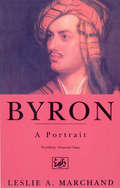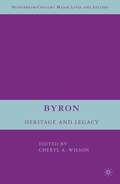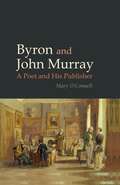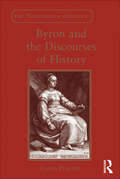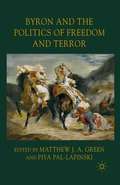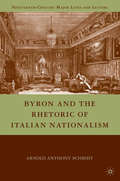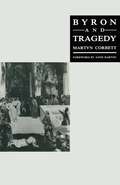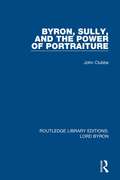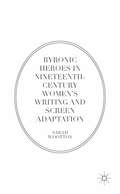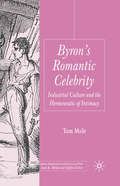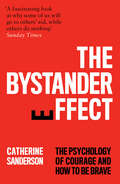- Table View
- List View
Byron: A Portrait (Byron's Letters And Journals #Vol. Vi)
by Leslie MarchandIt is his clear-sightedness, his candour, his steely strength of will, the immediacy of his writing, his insolence and cynicism, his love of liberty, his hatred of hypocrisy, his originality, his rational enlightened toughness which attached Byron to the present age as much as to his own. Leslie Marchand's profound knowledge of his subject is unrivalled. His superb biography gives us an engrossing and utterly convincing portrait of a genius - a man who more than any other, fulfilled in his brillance, passion and creativity, the ideal of the Romantic Hero. One cannot but be won over by the sensitive, infinitely complex which Leslie Marchand uncovers. . . he gives us the essential Byron. . The spell of this strange, unquiet, blazingly honest and infinitely endearing man, is powerful ' Selina Hastings. Daily Telegraph
Byron: Heritage and Legacy (Nineteenth-Century Major Lives and Letters)
by C. WilsonThis exciting collection represents a range of scholarly approaches and include close textual study, comparative readings, and broad cultural analysis. Contributors to this collection include Bernard Beatty, Peter Cochran, Marilyn Gaull, Charles E. Robinson, Andrew Stauffer, and Timothy Webb.
Byron and John Murray: A Poet and His Publisher (Liverpool English Texts and Studies #64)
by Mary O'ConnellByron and John Murray: A Poet and His Publisher is the first comprehensive account of the relationship between Byron and the man who published his poetry for over ten years. It is commonly seen as a paradox of Byron’s literary career that the liberal poet was published by a conservative publishing house. It is less of a paradox when, as this book illustrates, we see John Murray as a competitive, innovative publisher who understood how to deal with his most famous author. The book begins by charting the early years of Murray’s success prior to the publication of Childe Harold’s Pilgrimage, and describes Byron’s early engagement with the literary marketplace. The book describes in detail how Byron became one of Murray’s authors, before documenting the success of their commercial association and the eventual and protracted disintegration of their relationship. Byron wrote more letters to John Murray than anyone else and their correspondence represents a fascinating dialogue on the nature of Byron’s poetry, and particularly the nature of his fame. It is the central argument of this book that Byron’s ambivalent attitude towards professional writing and popular literature can be illuminated through an understanding of his relationship with John Murray.
Byron and Place: History, Translation, Nostalgia
by S. CheekeThis new study of Byron explores the 'geo-historical' - places where historically significant events have occurred. Cheeke examines the ways in which the notion of being there becomes the central claim and shaping force in Byron's poetry up to 1818. He goes on to explore the concept of being in-between which characterises Byron's 1818-21 poetry. Finally, Byron's complex nostalgia for England, his sense of having been there , is read in relation to a broader critique of memory, home-sickness and place-attachment.
Byron and the Discourses of History (The Nineteenth Century Series)
by Carla PomarèIn her study of the relationship between Byron’s lifelong interest in historical matters and the development of history as a discipline, Carla Pomarè focuses on drama (the Venetian plays, The Deformed Transformed), verse narrative (The Siege of Corinth, Mazeppa) and dramatic monologue (The Prophecy of Dante), calling attention to their interaction with historiographical and pseudo-historiographical texts ranging from monographs to dictionaries, collections of apophthegms, autobiographies and prophecies. This variety of discourses, Pomarè suggests, not only served as a source of the historical information Byron cherished, providing the subject matter for countless episodes in his works, but also and primarily supplied him with epistemological models. From them, Byron drew such trademark textual practices as his massive use of notes and paratexts, which satisfied his ingrained need for ’authenticity’ - a sentiment expressed in his oft-quoted, ’I hate things all fiction’. As Pomarè argues, Byron’s meticulous tracing of the process that links events, documents and historical representations ultimately answers his desire to retrieve what might be lost during the transmission of historical knowledge. Thus does he betray his preoccupation with the ideological uses of history writing, projecting his own discourses of history into the present of their composition.
Byron and the Discourses of History (The Nineteenth Century Series)
by Carla PomarèIn her study of the relationship between Byron’s lifelong interest in historical matters and the development of history as a discipline, Carla Pomarè focuses on drama (the Venetian plays, The Deformed Transformed), verse narrative (The Siege of Corinth, Mazeppa) and dramatic monologue (The Prophecy of Dante), calling attention to their interaction with historiographical and pseudo-historiographical texts ranging from monographs to dictionaries, collections of apophthegms, autobiographies and prophecies. This variety of discourses, Pomarè suggests, not only served as a source of the historical information Byron cherished, providing the subject matter for countless episodes in his works, but also and primarily supplied him with epistemological models. From them, Byron drew such trademark textual practices as his massive use of notes and paratexts, which satisfied his ingrained need for ’authenticity’ - a sentiment expressed in his oft-quoted, ’I hate things all fiction’. As Pomarè argues, Byron’s meticulous tracing of the process that links events, documents and historical representations ultimately answers his desire to retrieve what might be lost during the transmission of historical knowledge. Thus does he betray his preoccupation with the ideological uses of history writing, projecting his own discourses of history into the present of their composition.
Byron and the Politics of Freedom and Terror
by Piya Pal-LapinskiThis interdisciplinary collection explores the divergence or convergence of freedom and terror in a range of Byron's works. Challenging the binary opposition of historicism and critical theory, it combines topical debates in a manner that is sensitive both to the circumstances of their emergence and to their relevance for the twenty-first century.
Byron and the Rhetoric of Italian Nationalism (Nineteenth-Century Major Lives and Letters)
by A. SchmidtMaking extensive use of untranslated texts, Arnold Schmidt discusses the impact of Byron's life and works on the discourse of Italian nationalism between 1818 and 1948, his participation in Grand Tour and salon culture, and his influence on Italian Classicists and Romantics.
Byron, Sully, and the Power of Portraiture (Routledge Library Editions: Lord Byron)
by John ClubbeFirst published in 2005. Since the early nineteenth century, Byron, the man and his image, have captured the hearts and minds of untold legions of people of all political and social stripes in Britain, Europe, America, and around the world. This book focuses on the history and cultural significance for Federal America of the only portrait of Byron known to have been painted by a major artist. In private hands from 1826 until this day, Thomas Sulley’s Byron has never before been the subject of scholarly study. Beginning with the discovery of the portrait in 1999 and a 200-year narrative of the portrait’s provenance and its relation to other well-known Byron portraits, the author discusses the work within the broad context of British and American portraiture of the late eighteenth and early nineteenth centuries.
Byron, Sully, and the Power of Portraiture (Routledge Library Editions: Lord Byron)
by John ClubbeFirst published in 2005. Since the early nineteenth century, Byron, the man and his image, have captured the hearts and minds of untold legions of people of all political and social stripes in Britain, Europe, America, and around the world. This book focuses on the history and cultural significance for Federal America of the only portrait of Byron known to have been painted by a major artist. In private hands from 1826 until this day, Thomas Sulley’s Byron has never before been the subject of scholarly study. Beginning with the discovery of the portrait in 1999 and a 200-year narrative of the portrait’s provenance and its relation to other well-known Byron portraits, the author discusses the work within the broad context of British and American portraiture of the late eighteenth and early nineteenth centuries.
Byronic Heroes in Nineteenth-Century Women’s Writing and Screen Adaptation
by Sarah WoottonByronic Heroes in Nineteenth-Century Women's Writing and Screen Adaptation charts a new chapter in the changing fortunes of a unique cultural phenomenon. This book examines the afterlives of the Byronic hero through the work of nineteenth-century women writers and screen adaptations of their fiction. It is a timely reassessment of Byron's enduring legacy during the nineteenth century and beyond, focusing on the charged and unstable literary dialogues between Jane Austen, Elizabeth Gaskell, George Eliot and a Romantic icon whose presence takes centre stage in recent screen adaptations of their most celebrated novels. The broad interdisciplinary lens employed in this book concentrates on the conflicted rewritings of Byron's poetry, his 'heroic' protagonists, and the cult of Byronism in nineteenth-century novels from Pride and Prejudice to Middlemarch, and extends outwards to the reappearance of Byronic heroes on film and in television series over the last two decades.
Byron's Don Juan (Routledge Library Editions: Lord Byron)
by Bernard BeattyFirst published in 1985. What sort of poem is Don Juan, and how does it maintain its momentum through its long and often struggling narrative? These are the questions that Bernard Beatty proposes in this subtle and elegant discussion of Byron’s masterwork. The legend of Don Juan was entrenched in European literature and other arts long before it came under Byron’s hands, yet Byron’s treatment of the story is often almost unrecognisably far from its forebears. Beatty indicates how deeply Byron has assimilated his predecessors in order to produce his own work. The sustained argument of this book raises questions of interest not only to students of Byron but of comedy in general, as well as of the place of religious motifs in apparently secularised modes.
Byron's Don Juan (Routledge Library Editions: Lord Byron)
by Bernard BeattyFirst published in 1985. What sort of poem is Don Juan, and how does it maintain its momentum through its long and often struggling narrative? These are the questions that Bernard Beatty proposes in this subtle and elegant discussion of Byron’s masterwork. The legend of Don Juan was entrenched in European literature and other arts long before it came under Byron’s hands, yet Byron’s treatment of the story is often almost unrecognisably far from its forebears. Beatty indicates how deeply Byron has assimilated his predecessors in order to produce his own work. The sustained argument of this book raises questions of interest not only to students of Byron but of comedy in general, as well as of the place of religious motifs in apparently secularised modes.
Byron's Don Juan: A Critical Study (Routledge Library Editions: Lord Byron)
by Elizabeth French BoydWhen this book was published in 1945, interest in Byron’s poetry and appreciation of his titanic role in Romanticism had been steadily increasing. Of all his vast poetic production, Don Juan, the last and greatest of his major works, offers the highest rewards to the modern reader. It not only stands out among his poems as the best expression of Byron, but it ranks with the great poems of the nineteenth century as representative of the era, and of modern European civilization. This title will be of interest to students of literature.
Byron's Don Juan: A Critical Study (Routledge Library Editions: Lord Byron)
by Elizabeth French BoydWhen this book was published in 1945, interest in Byron’s poetry and appreciation of his titanic role in Romanticism had been steadily increasing. Of all his vast poetic production, Don Juan, the last and greatest of his major works, offers the highest rewards to the modern reader. It not only stands out among his poems as the best expression of Byron, but it ranks with the great poems of the nineteenth century as representative of the era, and of modern European civilization. This title will be of interest to students of literature.
Byron's Journal of his Circumnavigation, 1764-1766 (Hakluyt Society, Second Series)
by Robert E. GallagherIn 1764 the Hon. John Byron was commissioned by the Admiralty to sail to the South Atlantic to search for Pepys's Island and the Southern Continent. He was then to continue into the Pacific itself and look for a possible North-west passage. Although he rediscovered the Falkland Islands, it was after the French had done so under Bougainville, and he made no attempt to search for a North-west passage at all, but sailed straight on round the world, making no discoveries of any importance. The journal which Byron kept during his voyage has been edited and annotated by Dr Gallagher. In his Introduction he describes earlier voyages of a similar nature and sketches the background to this voyage. He assesses Byron's achievement and considers why he disobeyed his orders. Apart from the Journal, the Admiralty's 'secret instructions' to Byron are also printed here, as well as Byron's letter to the Admiralty explaining why he was sailing straight on. There is an appendix by Dr Helen Wallis on the Patagonian giants. This is a new print-on-demand hardback edition of the volume first published in 1964.
Byron's Journal of his Circumnavigation, 1764-1766 (Hakluyt Society, Second Series)
by Robert E. GallagherIn 1764 the Hon. John Byron was commissioned by the Admiralty to sail to the South Atlantic to search for Pepys's Island and the Southern Continent. He was then to continue into the Pacific itself and look for a possible North-west passage. Although he rediscovered the Falkland Islands, it was after the French had done so under Bougainville, and he made no attempt to search for a North-west passage at all, but sailed straight on round the world, making no discoveries of any importance. The journal which Byron kept during his voyage has been edited and annotated by Dr Gallagher. In his Introduction he describes earlier voyages of a similar nature and sketches the background to this voyage. He assesses Byron's achievement and considers why he disobeyed his orders. Apart from the Journal, the Admiralty's 'secret instructions' to Byron are also printed here, as well as Byron's letter to the Admiralty explaining why he was sailing straight on. There is an appendix by Dr Helen Wallis on the Patagonian giants. This is a new print-on-demand hardback edition of the volume first published in 1964.
Byron's Letters and Journals: A New Selection
by Richard LansdownAlongside Jane Austen, the Brontë sisters, and Oscar Wilde, Lord Byron possesses a star-quality unlike other classic British authors. His life as poet, philanderer, homosexual, and freedom fighter is legendary, and this new selection from his powerful letters and journals tells the story from the inside, in Byron's own racy and passionate style. Though Byron is chiefly known as a poet, his letters and journals are one of the glories of English prose literature, and one of the greatest British acts of autobiography, alongside Pepys' Diary and Boswell's Journal. This new selection, taken from the authoritative and unbowdlerized edition prepared by Leslie Marchand in the 1970s, not only provides the cream of his informal prose; it amounts to a biography in Byron's own words. No other English writer lived so remarkable an existence, from rented rooms in Aberdeen to a Nottinghamshire peerage, from European fame to English infamy, and notorious Italian exile to a glorious death in the Greek War of Independence.The letters and journals are selected, introduced, and annotated to provide a running narrative of the life and career of his remarkable man in his own unmistakable words.
Byron's Letters and Journals: A New Selection
by Richard LansdownAlongside Jane Austen, the Brontë sisters, and Oscar Wilde, Lord Byron possesses a star-quality unlike other classic British authors. His life as poet, philanderer, homosexual, and freedom fighter is legendary, and this new selection from his powerful letters and journals tells the story from the inside, in Byron's own racy and passionate style. Though Byron is chiefly known as a poet, his letters and journals are one of the glories of English prose literature, and one of the greatest British acts of autobiography, alongside Pepys' Diary and Boswell's Journal. This new selection, taken from the authoritative and unbowdlerized edition prepared by Leslie Marchand in the 1970s, not only provides the cream of his informal prose; it amounts to a biography in Byron's own words. No other English writer lived so remarkable an existence, from rented rooms in Aberdeen to a Nottinghamshire peerage, from European fame to English infamy, and notorious Italian exile to a glorious death in the Greek War of Independence.The letters and journals are selected, introduced, and annotated to provide a running narrative of the life and career of his remarkable man in his own unmistakable words.
Byron's Nature: A Romantic Vision of Cultural Ecology
by J. Andrew HubbellThis book is a thorough, eco-critical re-evaluation of Lord Byron (1789-1824), claiming him as one of the most important ecological poets in the British Romantic tradition. Using political ecology, post-humanist theory, new materialism, and ecological science, the book shows that Byron’s major poems—Childe Harold’s Pilgrimage, the metaphysical dramas, and Don Juan—are deeply engaged with developing a cultural ecology that could account for the co-creative synergies in human and natural systems, and ground an emancipatory ecopolitics and ecopoetics scaled to address globalized human threats to socio-environmental thriving in the post-Waterloo era. In counterpointing Byron’s eco-cosmopolitanism to the localist dwelling praxis advocated by Romantic Lake poets, Byron’s Nature seeks to enlarge our understanding of the extraordinary range, depth, and importance of Romanticism’s inquiry into the meaning of nature and our ethical relation to it.
Byron's Nature: A Romantic Vision of Cultural Ecology
by J. Andrew HubbellThis book is a thorough, eco-critical re-evaluation of Lord Byron (1789-1824), claiming him as one of the most important ecological poets in the British Romantic tradition. Using political ecology, post-humanist theory, new materialism, and ecological science, the book shows that Byron’s major poems—Childe Harold’s Pilgrimage, the metaphysical dramas, and Don Juan—are deeply engaged with developing a cultural ecology that could account for the co-creative synergies in human and natural systems, and ground an emancipatory ecopolitics and ecopoetics scaled to address globalized human threats to socio-environmental thriving in the post-Waterloo era. In counterpointing Byron’s eco-cosmopolitanism to the localist dwelling praxis advocated by Romantic Lake poets, Byron’s Nature seeks to enlarge our understanding of the extraordinary range, depth, and importance of Romanticism’s inquiry into the meaning of nature and our ethical relation to it.
Byron's Romantic Celebrity: Industrial Culture and the Hermeneutic of Intimacy (Palgrave Studies in the Enlightenment, Romanticism and Cultures of Print)
by T. MoleThis book offers a new history and theory of modern celebrity. It argues that celebrity is a cultural apparatus that emerged in response to the Romantic industrialization of print and culture. It investigates the often strained interactions of artistic endeavour and commercial enterprise, and the place of celebrity culture in history of the self.
Byron's Women
by Alexander LarmanOne was the mother who bore him; three were women who adored him; one was the sister he slept with; one was his abused and sodomized wife; one was his legitimate daughter; one was the fruit of his incest; another was his friend Shelley's wife, who avoided his bed and invented science fiction instead. Nine women; one poet named George Gordon, Lord Byron – mad, bad and very very dangerous to know. The most flamboyant of the Romantics, he wrote literary bestsellers, he was a satirist of genius, he embodied the Romantic love of liberty (the Greeks revere him as a national hero), he was the prototype of the modern celebrity – and he treated women (and these women in particular) abominably. In BYRON'S WOMEN, Alex Larman tells their extraordinary, moving and often shocking stories. In so doing, he creates a scurrilous 'anti-biography' of one of England's greatest poets, whose life he views – to deeply unflattering effect – through the prism of the nine damaged woman's lives.
The Bystander Effect: Understanding The Psychology Of Courage And Inaction
by Catherine Sanderson‘Fantastic … It explains the misperception of stacked odds and personal powerlessness that stops individuals challenging bad behaviour. Stunning. Humbling. Thought-provoking’Kathryn Mannix, author of With the End in Mind In the face of discrimination, bad behaviour, evil and abuse, why do good people so often do nothing?
